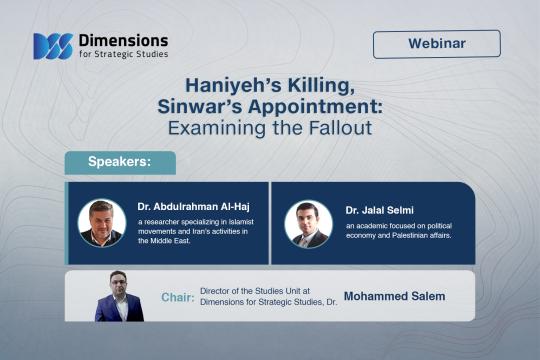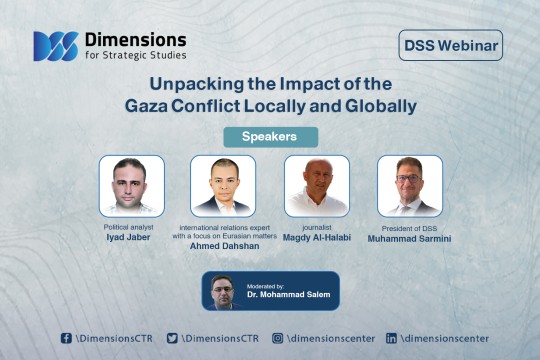
Pannel: India-Middle East-Europe Economic Corridor
2023-09-263796 view
The Dimensions Center for Strategic Studies (DSS) moderated a comprehensive panel discussion on the 'Ex' platform, akin to Twitter, delving into the geopolitical and economic implications of the India-Middle East-Europe Corridor.
The dialogue featured international economics specialist, Hassan Al-Shaghil, and political science professor, Dr. Adnan Abu Amer and moderated by Dr. Mohammed Salem, the director of the studies unit at DSS.
The participants touched upon the significance of such an economic corridor, agreed upon by leaders from the United States, Saudi Arabia, and India, especially in the context of economic tensions with China, the proponent of the Belt project that connects China to Europe through the Middle East.
The discussion shed light on the potential impact of the agreement on the Middle East and North Africa region. It emphasized key points, exploring the implications and timing of announcing an Indian economic corridor, especially amidst the rising inflation rates worldwide.
Al-Shaghil believes that the Indian economy is not among the strongest in the world and faces many structural issues due to problems centered around the social fabric, nutritional level, and institutional framework.
According to Al-Shaghil, India's rapidly growing economy, despite its continuous development, has a GDP that doesn't exceed $4 trillion—a figure that seems less impressive against the backdrop of its vast population of approximately 1.4 billion people.
In discussing the challenges hindering India from becoming a central hub for this project, Al-Shaghil points out the limited diversity of Indian industries. However, he suggests that by faithfully executing its developmental blueprint set to culminate by 2045, India could potentially rise as a formidable global economic player.
Al-Shaghil emphasized India's role predominantly as an importer, with its exports not sufficiently substantial to match the magnitude of the proposed corridor. He asserted that India's investment environment stands in stark contrast to China's. India's combination of liberal policies within a socialist framework means that, at least for now, it's not poised to replace China, especially considering the superior skill level of Chinese workers.
Lastly, Al-Shaghil expressed reservations about the overarching significance of the corridor. A pivotal concern is that the project traverses countries with open economies, implying limited impact on both Middle Eastern and European Union countries. This contrasts with the Silk Road, which passes through Central Asian nations, bringing tangible benefits as goods transit through them.
Dr. Abu Aamer asserts that the initiative announced by President Biden during the recent G20 summit in New Delhi isn't novel in concept. He recalls Israel's past endeavours, particularly the "Rails of Peace" project—a proposed railway line meant to connect Israel with Jordan and the Gulf countries. However, it didn't bring about significant changes.
Furthermore, Biden reminded that Israel, less than a year prior, introduced another rail project aimed at bridging the UAE and Israel. It too didn't find success, mainly owing to Israel's intricate political scenarios and its apparent hesitance in solidifying relations with its Arab neighbours.
Expanding on the essence of the new project, Dr. Abu Aamer describes its ambition: to forge a land route commencing from India, cutting through the Gulf nations and Jordan, and finally reaching a port in Greece. The project, he explained, has been propelled majorly by the U.S. under Biden's administration. Given the murmurs of a potential normalization between Saudi Arabia and Israel, Biden possibly envisions this project as an "electoral gift" to appease various stakeholders.
It's notable that the blueprint of this economic corridor was mutually agreed upon by the leaders of the U.S., Saudi Arabia, and India during the G20 summit. More detailed plans regarding its execution are expected to be unveiled within the subsequent sixty days, following the memorandum of understanding's endorsement.





